Tong, Yorkshire
| Tong | |
| Yorkshire West Riding | |
|---|---|
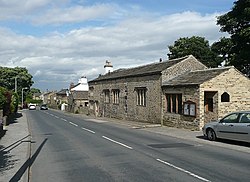 Village hall on Tong Lane | |
| Location | |
| Grid reference: | SE221307 |
| Location: | 53°46’16"N, 1°40’8"W |
| Data | |
| Post town: | Bradford |
| Postcode: | BD4 |
| Dialling code: | 01274 |
| Local Government | |
| Council: | Bradford |
| Parliamentary constituency: |
Bradford South |
Tong is a village in the West Riding of Yorkshire, found four miles south-east of Bradford city centre, standing on a prominent ridge between Pudsey Beck and Cockers Dale.
The name 'Tong' is derived from its location between the two valleys, from the Old English term tang, meaning 'tong' or 'fork', such as a river fork.
Historically this place was within the parish of Birstall
History
There is little remaining evidence of any permanent settlement of the area from prehistoric to Roman times, St James Church provides evidence of an earlier settlement of some importance at Tong in Anglo-Saxon times: excavations undertaken during the restoration of the church in the 1970s uncovered the fragmentary walls and foundation stones of two earlier buildings contained within the footprint of the remains of a Norman-era church which was built circa 1140.[1]
The Domesday Book of 1086 records that Stainulf owned the manor before the Conquest, after which it passed to Ilbert de Lacy, who is recorded in the survey as holding 162 manors.
Asolf, an extensive landowner in West Riding, appears to have been lord of Tong Manor from around 1135 to about 1159 and it is therefore probably he who rebuilt the church in about 1140 on the site of the demolished pre-Conquest church. Asolf had many sons, who, instead of taking the name Fitzasolf (son of Asolf) were named after where they were made lord of the manor on their father's death. The de Tang family descended from him continued to hold the manor until the death of Hugh de Tong in 1445 and the passing of the manor to his grandson, John Mirfield.
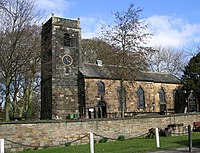
The village was an integral part of the Tempest estate, comprising workers' cottages, farmsteads and ancillary buildings. By 1725 a linear settlement extended eastwards from the chapel, towards Keepers Lane and Hill Green. Dwellings were mainly located to the front of Tong Lane with barns or outbuildings to the rear. It is believed settlement may have initially comprised two focal points, near the church and at Hill Green. Rebuilding work/renovation of village buildings, undertaken by the Tempests, occurred in the 17th and early 18th centuries.
The works by the estate included rebuilding of the 12th-century chapel, carried out by Sir George Tempest in 1727, and the construction of the village school and master's house in 1736. A vicarage also superseded the parsonage adjacent to the church. Church Farmhouse similarly dates from the 18th century. The Temple Estate remained until the Hall and estate were sold in 1941, to E. W. Towler director of Redpath Dorman and Long.
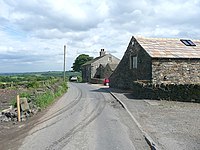
The preservation of the Hall and Park, and the Estate's influence on development has helped maintain the character of the village and buildings within it. Many buildings date between the 17th and 18th centuries, with Tong Hall and gatepiers to the entrance of the drive listed respectively as Grade I and Grade II* listed structures. Despite modern residential development the layout of the linear settlement today is very similar to that recorded in 1725.
About the village
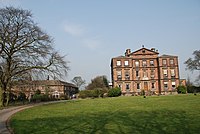
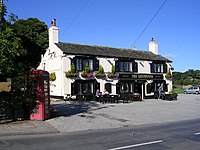
The parish church, St James's Church, was built in 1727. Soon afterwards came the village school, in 1736.
Tong Hall, a Queen Anne-style manor house built in the late 17th century, replaced an older building recorded in 1343. Sir George Tempest built the present Tong Hall in 1702 to designs by Theophilus Shelton. Further alterations took place in 1773 under the direction of architect John Platt. It was sold in 1941, and is now a business centre with suites of offices.
The Greyhound public house is a traditional pub and restaurant. Adjacent to the Greyhound is a small village cricket ground, home to Leeds And West Riding League Tong CC, who play their home games at one of Yorkshire's oldest cricket grounds.
Outside links
| ("Wikimedia Commons" has material about Tong, Yorkshire) |
References
- ↑ Stephen Tonge. "Tong of Tong, Bradford – conservation area". Tongefamily.info. http://www.tongefamily.info/resources/tong_bradford.htm.
